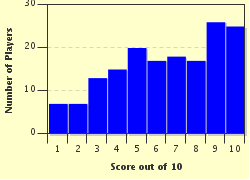Quiz Answer Key and Fun Facts
1. Complex numbers come in two parts and are seen in the form 'a + bi' where 'a' and 'b' are constants and 'i' is given the dreamy name, the imaginary unit. Which of those letters represents the *real* part of the complex number?
2. It is just a single letter that represents the difference between the real numbers and the complex numbers, and that letter is 'i'. What mathematical value does the letter 'i' represent?
3. All the main arithmetic functions (addition, subtraction, multiplication and division) can be applied to complex numbers of the form 'a + bi'. So, if there are two complex numbers, 'Z1 = a + bi' and 'Z2 = c + di', what is the value of 'Z1 + Z2'?
Clue: Add the real terms and imaginary terms separately.
4. The division of a complex number by another complex number requires a little bit of algebraic manipulation before the arithmetic takes place. If there are two complex numbers, 'Z1 = a + bi' and 'Z2 = c + di', what must be found if 'Z1' is to be divided by 'Z2'?
5. Complex numbers don't just exist for the purpose of trivial addition and subtraction. There are many elegant formulae which involve complex numbers and one such formula is:
[cos(x) + sin(x)i]^n = cos(nx) + sin(nx)i
Who is this formula named for?
6. The imaginary unit, 'i', makes an appearance in the famous mathematical formula:
e^(ix) = cos(x) + sin(x)i
This wonderful, elegant formula links 'e^(ix)' to a unit circle and is useful in simplifying the analysis of differential equations. Who of the following is this formula named for?
7. Every now and again one hears a mathematician talk of the beauty of their subject and one particular identity is often heralded as the most beautiful of all. This identity is derived from the formula, 'e^(ix) = cos(x) + sin(x)i', and involved pi, 'e', and the imaginary unit, 'i'. After which of the following was the identity '[e^(i*pi)] + 1 = 0' named?
8. Complex numbers can be plotted on a two-dimensional plane, known simply as the complex plane. The two dimensions are in the x-direction and in the y-direction. Does the imaginary part of a complex number dictate how far along the x-axis a plot point is?
9. Complex numbers are often considered vectors due to their similarities, particularly in arithmetic. Just as is the case with vectors, what is another name for the absolute value of a complex number?
10. It seems quite extraordinary when a word such as "imaginary" is heard when considering a number, that such a number has real-life applications in science! Which of the following analyses uses complex numbers in its dealings with waves and signals?
Source: Author
jonnowales
This quiz was reviewed by FunTrivia editor
crisw before going online.
Any errors found in FunTrivia content are routinely corrected through our feedback system.

